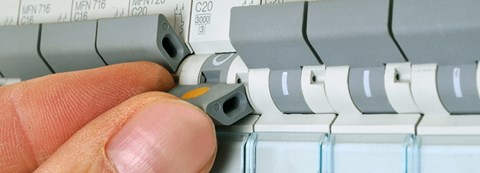Blown fuses
A complete or partial outage of electricity in your apartment may be due to blown fuses protecting the electricity connection or the property network. You can replace the fuses that are inside the apartment distribution panel. Check the fuse sizes in your apartment, and buy a few spares of each fuse size.
The fuses can be found in the technical utility room of an apartment or in a distribution panel in the hallway with the main fuses, main switch, electricity meter, and fuse blocks.
Particularly in apartment buildings and terraced houses, there is often a switchboard located outside the apartments. In this case, there is a separate distribution board, or fuse panel, inside each apartment, which contains an apartment-specific main switch and fuse blocks.
Replacing a fuse block
If some of the wall sockets and electrical devices are still working, it may be a sign of a blown fuse block. If the fuse is blown because of a faulty electrical appliance, or you suspect there is a fault in your electrical equipment, turn off the device immediately and take it to a specialist for repair if necessary. An overload can also cause a fuse to blow.
- An automatic circuit breaker can be pushed back into the operating position.
- If the fuse is a conventional plug fuse, turn off the main switch by turning the switch to the 0 position before replacing the fuse.
Replace a blown fuse with a similar new and intact one. - Check the fuse size from the colored label on the end of the fuse, on the nameplate next to the fuse, or from the color on the bottom of an unscrewed fuse. The fuse size is also indicated in numericals on the bottom of the fuse.
- If the fuse blows or the circuit breaker snaps down again as soon as it is switched on, disconnect the electrical devices affected by the fuse in question and reconnect them one by one.
- First, disconnect the power supply by removing the fuse or opening the circuit breaker. Turn the electrical device on and then turn the power back on.
- If the fuse blows or the circuit breaker snaps down when the device is used, the device is broken and should not be used.
- If no individual electrical device blows the fuse, it may be a sign of an overload, meaning more electrical equipment is switched on than is allowed by the fuse's maximum operating current. This is especially common in old houses with fuses that are not suited for as many electrical appliances as we use today.
Replacing the main fuse
In high load cases, such as when the temperature is at its lowest, such a large current may flow through the main fuse that the fuse blows. In this case, at least part of a connection will be left without electricity. Therefore, it is advisable to avoid the simultaneous use of high-powered electrical appliances, such as an electric oven and heater, when the temperature is at its lowest.
Main fuses are connection-specific, so if one blows, it does not affect the electricity distribution of other connections in the area.
- There are usually three main fuses installed in a column, in a distribution cabinet, or in a switchboard. You can replace the main fuses inside the switchboard of a property yourself.
- Be sure to follow all electrical safety instructions and turn off the main switch by turning the switch to the 0 position before replacing a fuse. Note! There is electric tension at the base of the main fuse even when a fuse has been removed and the main switch is in the 0 position.
- Under no circumstances should the main fuse be replaced by a fuse with a higher rated current than the one on the main fuse, as the protection will not work and a fuse meant for too high a current could cause a fire. Fuses are designed to protect electrical wires in a way that they blow quickly enough in the event of a fault or an overload. If the main fuse is replaced with a fuse with a much higher rating, the wires may overheat and catch fire.
- For instructions on replacing a main fuse by yourself, please contact our fault service.
- Main fuses located in a column, distribution cabinet, or a locked enclosure with an Oulun Energia Sähköverkko Oy lock may only be replaced by the network company's on-call fault service technician. Call our on-call fault service to request a replacement.
Report an outage to our 24-hour on-call number for electricity supply
If a fuse blows repeatedly
If a main fuse blows repeatedly, the fuse size of your electricity connection is too small or the load is unevenly distributed over the fuses. If a new fuse blows immediately after replacement, the fault is in the wires or electrical equipment. In order to solve the matter, we recommend that you contact an electrical contractor, who will make the necessary repair and determine the total load on the connection and the possible need to increase the size of the main fuse of the connection.
We charge an additional connection fee for increasing the size of a main fuse, which is the difference between the connection fees for the current fuse size and the new main fuse size if the wiring does not need to be replaced. For larger modifications, you can ask for a separate price estimate from our technical support.
Permissible loads for the most common household fuses:


